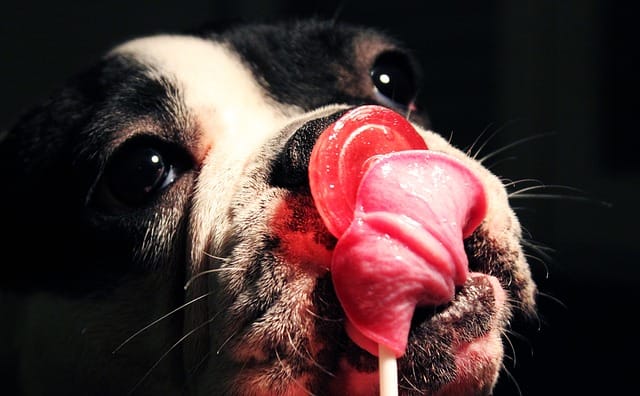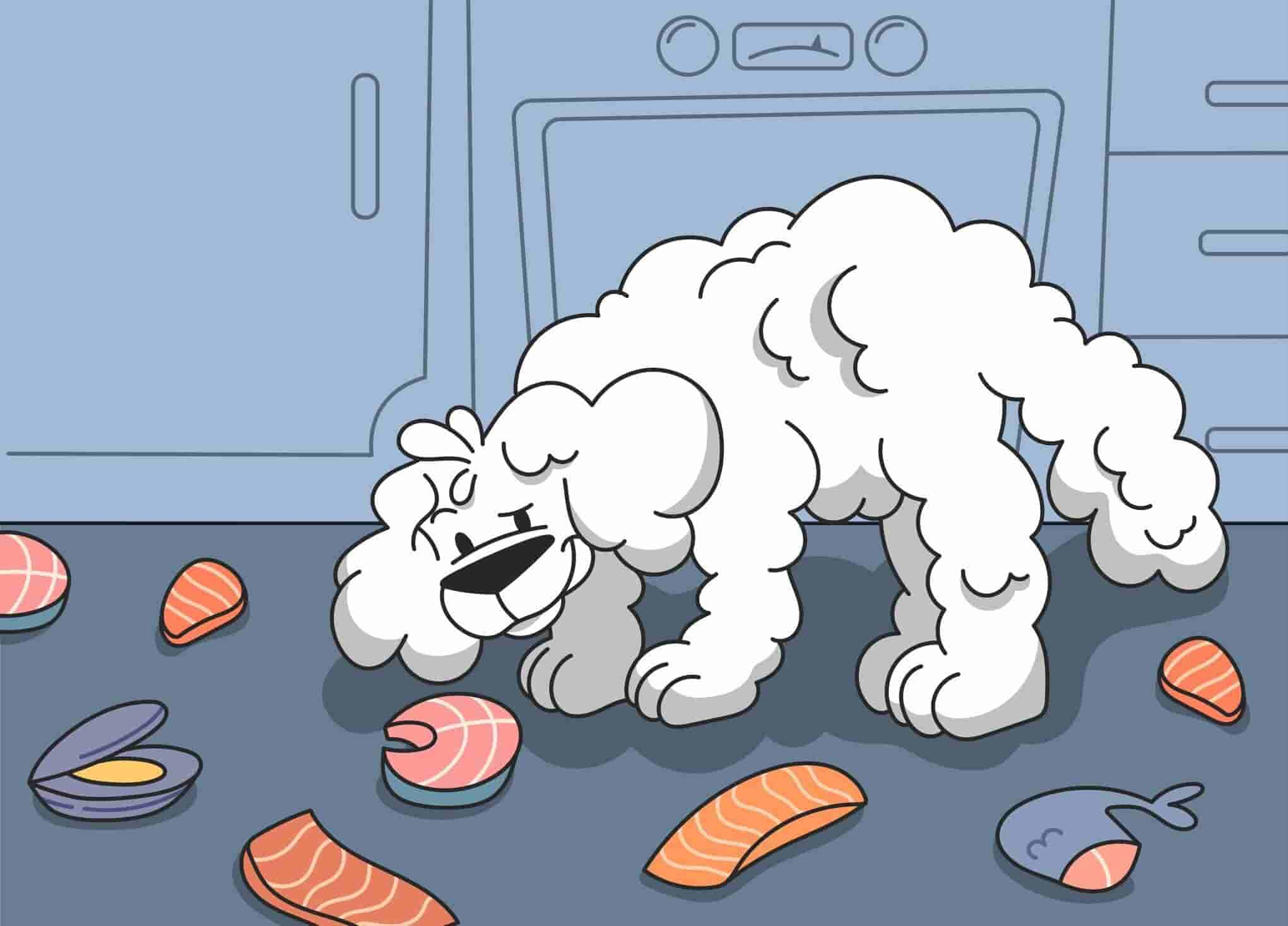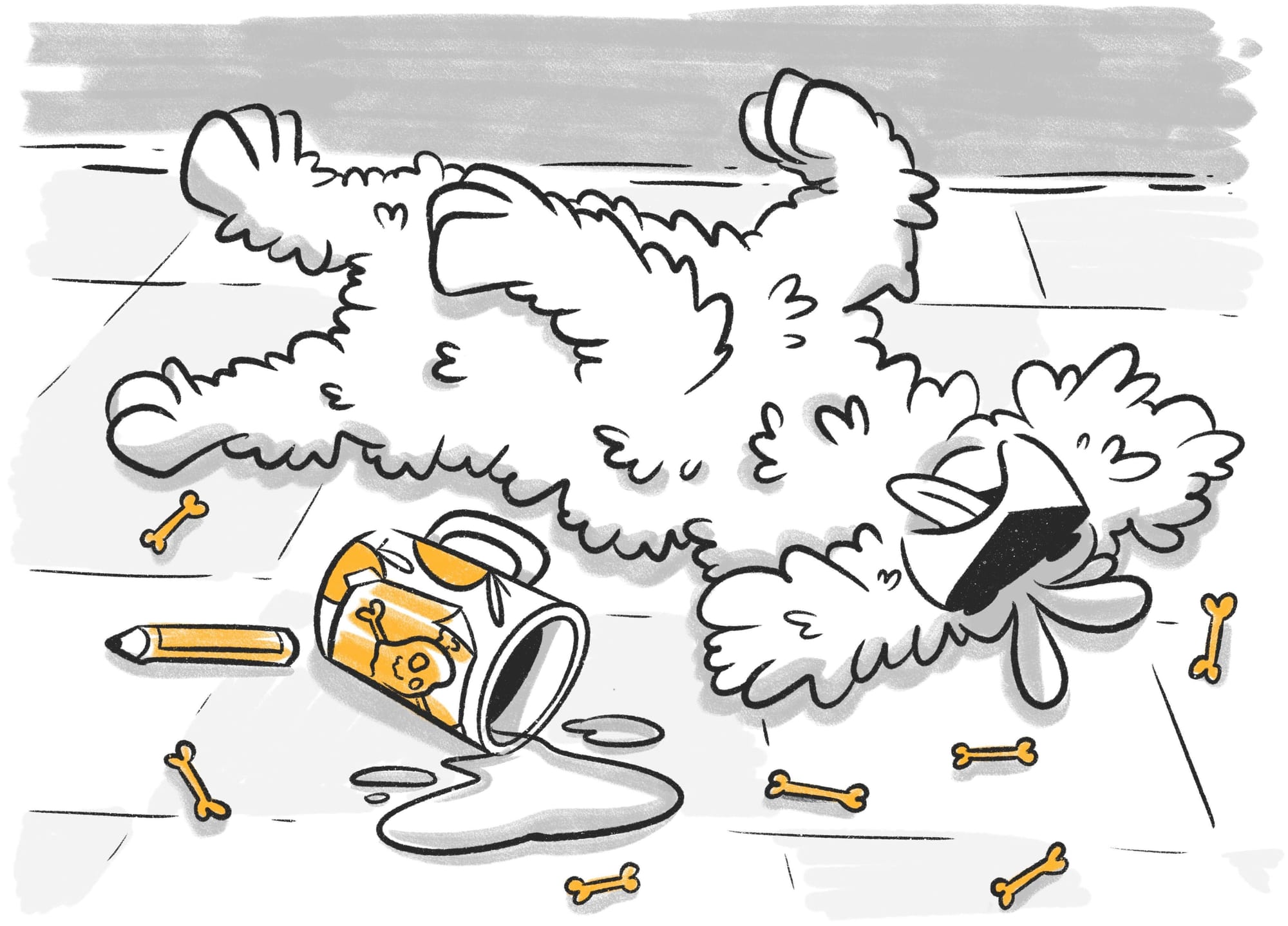You’re trying to enjoy your sushi takeout, but your dog’s pleading eyes are spoiling your meal. Should you risk giving them a bite, or is seafood dangerous for pets?
Omega-3 fatty acids, low fat content, and high protein levels: we all know the benefits of eating fish. On the other hand, high levels of mercury and other toxins in polluted environments make a lot of health experts question the safety of seafood in general.
But, what does that mean for our four-legged companions?
Before you take the bait, find out what are the benefits and the risks, as well as which types of seafood you should feed your dog, and which are best left to the sharks.
Stop Googling - Ask a Real Vet
Content:
- Should You Feed Seafood to Your Dog? Benefits & Risks
- Seafood Dogs Can Eat
- Seafood You Should Avoid
- Seafood You Should Never Give to Your Dog
- The Takeaway
Should You Feed Seafood to Your Dog?
Even if there was no ongoing debate about the benefits and healthiness of marine foods, the question remains: is it safe for a dog to eat fish, shrimp, or any other type of seafood?
The short answer is that dogs can eat some types of seafood, but it all depends on the species, and the method of preparation. Unsurprisingly, dogs do best with fish, whereas clams, shellfish, shrimps and other aquatic critters usually come with a set of warnings before serving.
Here are some general pointers as to what to look for in fish before you feed it to your furry baby:
- Lifespan: Always go for shorter-lived species of fish. In species with longer lifespans, such as tuna, mackerel, or sea bass, high levels of heavy metals and toxins accumulate over their lifetime. These metals become concentrated in the tissues of larger fish; in bigger fish, they reach levels that could cause severe illness in humans.
- Size: The same rule applies when it comes to size. Smaller fish have less mercury, while bigger specimens tend to accumulate it, as they eat massive quantities of other fish. Opt for fish no longer than 6 inches in length, such as sardines, anchovies, or herring.
- Bones: Fish that are hard to clean of bones are a safety risk for dogs. Brittle bones can tear through your dog’s intestine wall and pose a choking hazard.
- Fat Content: Fat is a great source of energy for dogs, provided it is the right kind of fat. Fish that contain high levels of omega 3 fatty acids are a great option. Omega 3 fatty acids can help lower your dog’s cholesterol levels, improve their coat’s health, and reduce their risk of heart disease. They can also increase your dog’s longevity.
- Smell: Smell is a good indicator of freshness. The more fishy and ammonia-like the smell, the more likely it is to be rancid and dangerous for your dog.
Of course, even with seafood and fish that are safe for dogs, moderation is key. While your pooch might benefit from an occasional meal, this type of food shouldn’t make up most of their diet.
Benefits of Feeding Seafood to Dogs
Considering how much attention you need to pay to when choosing safe seafood for dogs, you might give up on the idea altogether. However, fish and seafood should be included in your pooch’s meals, at least from time to time, because of the benefits these foods offer:
- Omega-3 fatty acids
- High protein levels
- Rich in phosphorus, calcium, iron, zinc, magnesium, potassium, copper, manganese, selenium, iodine, and vitamins A, B1, B2, B6, B12, C, D, E, and K
- Low levels of unhealthy fat
- High amount of antioxidants
- Excellent alternative for dogs with allergies (to other protein sources)
- Highly digestible
Risks of Feeding Seafood to Dogs
In some cases, the risks can outweigh the benefits. Not all seafood is rich in nutrients needed in a dog’s diet, and some of them can even be harmful to your pooch.
- Presence of toxins, heavy metals, and other pollutants
- Commercial pet foods with fish can contain harmful preservatives
- Risk of contracting bacteria, such as salmonella and listeria, as well as parasites, such as roundwords and tapeworms (if raw or not cooked properly, especially in farmed fish)
- Possible allergic reactions
- Risk of thiamine deficiency
- Bones, shells, and scales can cause choking and intestinal blockage

Although dogs can eat seafood and fish, it’s essential to prepare it adequately and choose the right type of seafood. If you’re unsure what seafood exactly can you feed your dog, check out the two lists below:
Seafood Dogs Can Eat
In general, fish that has been deboned, cleaned properly, and thoroughly cooked, is safe for canine consumption. However, feeding your pooch high amounts of fish, regardless of how it’s served, it can lead to thiamine deficiency. Thiamine deficiency can have severe consequences for your pet’s health and even lead to death in more extreme cases.
Uncooked fish is rich in nutrients and often appetizing to dogs, but it can also contain flukes, tapeworms, or roundworms. Apart from cleaning it, you should freeze raw fish for a few weeks before feeding it to your pooch, to eliminate any potential of nasty parasites hiding about. When you want to serve your furball’s meal, just thaw it, and you’re ready to go!
Salmon (Cooked)
Boneless salmon fillets are considered a premium meal for any pooch, but only if the salmon wasn’t farmed. Cooked salmon is a quality source of essential fatty acids and proteins, and you can include it in your dog’s diet without having to worry about long-term side effects. Just make sure not to feed it to your dog more than once or twice a week, and follow portion recommendations.
Sardines
These small fish are often referred to as the healthiest fish in the sea, as they eat only planktons and don’t live long, which means that their exposure to heavy metals and toxins is minimal. Feed them raw or cooked. Canned sardines are usually high in sodium, and the high levels of sodium can be harmful to your dog’s health. Don’t let the tiny size of these fish fool you: they pack quite a punch when it comes to nutritional values, so be careful with the portions, especially with chubby pups.
Herring and Anchovies
Little they may be, but these types of fish are very rich in omega-3 acids. Herring and anchovies are great additions to a dog’s diet, but only if served raw or properly cooked. Smoked, pickled, marinaded or canned fish is not recommended, as it contains other ingredients that might harm your pooch.
Krill Oil
Some people avoid giving fish to their dogs, whether because of the hassle or because they can’t find trusted sellers in their area. But, canines still need fatty acids, and the easiest way to introduce it to their diet is supplementing their meals with a tablespoon or two of oils rich in omega-3. Krill oil is a popular alternative to fish oil because it contains all the nutrients without the risk of toxins. It is made of minuscule crustaceans and a good source of fatty acids.
Seaweed
Same as with humans, seaweed is considered something of a superfood. Different types of seaweeds come in various forms, but in most cases, it is in dried sheets or powder. Sprinkle a little of this mineral and vitamin-rich food in your dog’s bowl to reap the benefits!
Seafood You Should Avoid
Tuna
Even though it is quite tasty, fresh tuna contains the highest levels of mercury. Mercury poisoning can have fatal consequences, and regularly feeding your pooch tuna is bound to have long-term effects. However, if your pooch happened to eat a little bit of tuna, it won’t harm them. Just avoid giving them tuna on a regular basis.
What about canned tuna? Apart from preservatives and additives that can be harmful to your dog, the specific type of fish that is used for making canned tuna rates even higher on the mercury contamination list. Canned fish, in general, is a terrible choice for pooches, so steer clear of this one!
Fish Oil
After many years of being the most popular choice for omega-3 supplementation, fish oil ended up on the list of nutritional undesirables. Why? Because of high levels of pollution in our oceans, fish oil can contain arsenic, mercury, cadmium, and lead, all of which can lead to canine cancer and cause irreparable damage to a dog’s nervous system.
Shellfish (Shrimp, Lobster, Crab)
When cooked and thoroughly cleaned of their shells and nasty bits, shrimps, lobsters, and crab can be eaten by dogs. However, only the meat of the shellfish can be served to dogs, and only if it’s fresh and properly cooked (no leftovers!). A few bites won’t harm your dog, but feeding it as a meal is not advised. Lobsters are full of sodium and high in fat, shrimp are often full of harmful toxins, and crab meat is very high in iodine. And even in cases where shellfish was a one-time treat, there is a risk of allergy reactions. All things considered, it’s better safe than sorry!
Bivalve Molluscs (Clams, Scallops, Oysters)
A teensy bite of clams, scallops or oysters (presuming they were cooked) won’t kill your dog. But, giving them as a meal can cause serious problems - and I’m not even talking about the hard shells that can cause trouble of a different kind. Bivalves such as these are treasured for the fact they filter water, but all those toxins end up in their tissue. For example, if your pooch gobbles up a bivalve that has dinoflagellates in its flesh, it can cause paralytic shellfish poisoning.
Sushi
The potential for your pooch to contract parasites from raw fish is the least problematic thing about feeding your dog sushi. Depending on the preparation process, sushi can contain a lot of ingredients that are not safe or recommended for dog consumption, such as avocado or rice vinegar. So, next time you order takeout, keep it all for yourself! (Sorry, Fido!)
Fish Sticks and Imitation Crab Meat
Both of these foods are made from fish, or, to be more precise, whitefish species and a lot of starch. They are not harmful per se, and it won’t bother your pooch if they ate a fish ‘finger’ or two, but they have no nutritional value. Giving your dog imitation crab meat or fish sticks as a part of their regular diet offers no benefits, but the poor quality ingredients could cause concern in the long run.
Seafood You Should Never Give to Your Dog

Raw Salmon and Smoked Salmon
It might be a delicacy to you, but salmon that wasn’t properly and thoroughly cooked (smoked doesn’t count) could kill your dog. Raw salmon can contain a parasite called Neorickettsia helminthoeca, which leads to salmon poisoning in dogs.
Unfortunately, canines are the only animals that are fatally affected by this parasite, so it’s best never to feed your dog salmon that wasn’t thermally processed. Keep in mind that this parasite takes about 2 weeks to incubate. So, if your dog ate raw salmon and feels fine now, it may still mean your pup could have contracted it and has no symptoms showing yet.
Farmed Fish
Farmed fish should be avoided in general, as they are often fed low-quality foods and dosed with antibiotics, pesticides, and hormones in large quantities. These poor fish are kept in small, dirty ponds and gorged on GMO corn, soy, and, in some cases, even garbage. Of course, not all farmed fish are kept in these despicable conditions - if you buy farmed fish with an Aquaculture Stewardship Council (ASC) seal, you can feed it to your pooch without having to worry.
Fish Bones
Brittle, very sharp and hard to spot - fish bones are extremely dangerous to dogs. Even though there will always be that friend of your uncle’s wife whose dog ate a fish bone and nothing happened, it’s not an excuse to risk painful or even fatal injuries. Fish bones are sharp enough to puncture the stomach or intestines, causing internal bleeding.
Shrimp Tails and Shrimp Shells
Your pooch might be tempted to nibble on these, but they can be a choking hazard and shells can turn into shards if your dog manages to crack them down. As a rule of thumb, it’s best to forget about any ‘yummies’ that can cause an impromptu visit to the vet, and seafood shells can cause a lot of trouble. If your dog accidentally ate a shrimp shell, contact a vet online. With Vet Chat, you will get a timely response and clarify all the necessary actions to track your pup’s behavior.
Because there are risks of poisoning and injuries, awareness and monitoring is important to prevent our dog from ingesting things that can harm them. However, we can’t be 100% sure that our dog won’t get into an accident or emergency. Because of this, we also have to find ways to prepare for such situations. With Petcube’s Pet Emergency Fund, you and your pet are given the support that you need during pet emergencies.
The Pet Emergency Fund has coverage and terms with you and your pet in mind. Each subscription covers $3000 annually for upto 6 pets (not just 1) for pet emergencies. They also have an online vet service where you can consult with certified veterinarians anytime. After treatment, they pay your vet bill without hassle and worry involved. That way, you get to focus on your pet’s road to recovery.
Good news! As one of our dear blog readers, you get an exclusive 27% off on subscriptions when you follow this link.
The Takeaway
Dogs have much to gain from having seafood and fish on the menu, but some marine creatures are probably not worth the risk.
Whether you’re feeding a raw diet to your four-legged best friend, or want to treat them to a home-cooked meal, when it comes to fish and seafood, it’s essential to prepare it the right way. Always clean, debone (or de-shell), and cook thoroughly anything you plan on serving to your dog.
And don’t forget: whenever you’re introducing something new to your dog’s diet, start with small portions to eliminate the risk of allergies or potential side effects.
Bon Appétit!
Was this article helpful?
Help us make our articles even better









